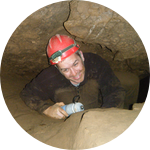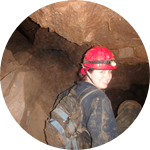About This Project
Cave systems are an important part of the landscape, but are also hidden in the subsurface and therefore are not often the first consideration or concern. However, understanding the subsurface environment is key in protecting water resources and the subterranean ecosystem. This research focuses on the sedimentology, using sediment samples, sediment cores, and morphological characteristics to explore subsurface sediment transport in an active Kentucky cave system with a unique history.
Ask the Scientists
Join The DiscussionWhat is the context of this research?
Cave sedimentology studies include exploring sediment transport and deposition within cave systems. It is a currently expanding and dynamic area of research with applications such as paleoclimatic reconstruction, determination of stream incision rates, and environmental applications (White 2007; Springer et al 1997).
The primary study site for this project is Hidden River Cave in Horse Cave, Kentucky, USA. Hydrogeologically related to the nearby Mammoth Cave system, Hidden River Cave has a history of contamination due to improper disposal of domestic and industrial waste and subsequent restoration of the cave. This cave system is a unique, active system that is understudied and provides a good study site to expand research on cave sedimentology.
What is the significance of this project?
Using remnants of contamination in the sediment record, we can further understand how water, sediment and potential contaminants move through the cave system. This includes our findings of microplastic, "plastic particles less than 5mm in diameter" (Baldwin et al 2016), in cave sediment samples.
Karst aquifers are susceptible to pollution due to the soluble nature of the rock and high development of subsurface drainage pathways. Therefore, water and wastewater management on karst terrain is important, directly relating to quality of subsurface water and in turn the quality of cave ecosystems. This research is applicable in communities dependent on karst landscapes for drinking water, such as McMaster's own Hamilton, Ontario!
What are the goals of the project?
I have visited Hidden River Cave a couple times in the past year as part of my work on this project. Much of these visits consisted of qualitative understanding of the physical and spatial relationships between the cave passages, with some sediment sampling completed. Surface sediment and select sediment cores are being analyzed for presence of microplastic, and select sediment cores have been run through an Itrax core scanner to obtain elemental data.
This fundraiser would allow a trip planned to retrieve water depth sensors - placed in August 2016 - to be extended. Another trip to Hidden River Cave will allow us to further qualitatively and quantitatively explore patterns between cave passages and gather sediment cores and surface samples in areas where there are gaps in our data.
Budget
To have 5 days possible to work in the cave, a 7 day trip is required. Funds raised will help cover the costs of travel and accommodations in Kentucky.
We will rent a car to drive from McMaster to Kentucky, as it is the best way logistically to get there: $390 rental for 1 week + 2050km round trip * 0.09$/km gas = $575
We have previously stayed at Jellystone Park Mammoth Cave, KY, which works great because we can save money on food by cooking and it allows space for field equipment: 6 nights * $145/day + taxes = $925
Additional funds raised would go towards field equipment costs.
Endorsed by
Meet the Team
Samantha Feist
I am a BSc graduate of the University of Guelph and a second year Master's student at McMaster University in Hamilton, Ontario. My first time in a cave was in August 2015, assisting with field work before I started my Master's. After that trip, I realized that there were still many unanswered questions in this cave system and decided to continue the cave sedimentology work in my Master's thesis. I am excited about this work because it is in a very unconventional research environment, and has so much potential for furthering the science of sedimentology in caves. My year of experience working on this cave system and continued collaboration with people in Kentucky at Hidden River Cave and the American Cave Conservation Assocaition will allow for continued research and development of ideas towards understanding cave sediment transport processes.
Additional Information
Hidden River Cave was previously used for hydroelectric power generation and tourism. However due to severe pollution, the cave was closed in 1943 for over 50 years until a new sewage treatment plant and remediation efforts allowed the cave to begin to recover. Today, the cave is open to tourists, as part of the American Cave Conservation Association at the American Cave Museum in the town of Horse Cave, KY. Check out their website here!
McMaster University has run a field experience course at Hidden River Cave multiple times in the past years. Here's an article about one of the field experiences on the McMaster Daily News!
Our research team was also featured in a local Kentucky newspaper, the Glasgow Daily Times, talking about our research in the cave!
If you donate at least $20 and our project is successful, we will include your name in the acknowledgements section of a published paper!
Project Backers
- 6Backers
- 8%Funded
- $115Total Donations
- $19.17Average Donation

